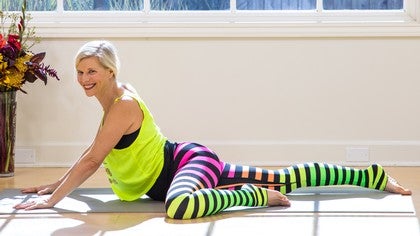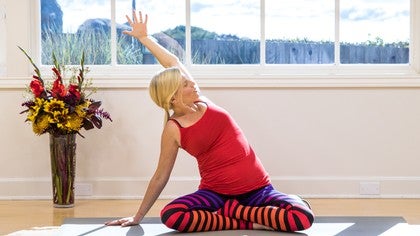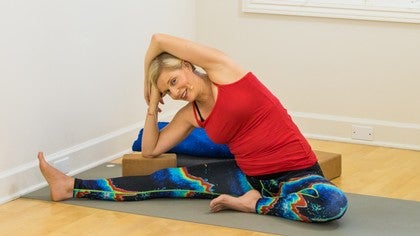Description
Transcript
Read Full Transcript
Hello, Yogi friend. I'm glad you're joining me today. Let's get started. So we're starting off today in a cat and cow. So we're going to come on to all fours position and you'll be in like a tabletop with your hands approximately under your shoulders and your knees approximately under your hips.
But just feel stable here. That's the most important thing, really. You just want to feel comfortable and stable. And then I usually start with a nice big inhale and then exhale around the spine up towards the ceiling into a cat. And then your inhale, you might let the belly drop down into your cow.
So we're just going to start going back and forth here. And I want you to know that I'm not the breath police, so certainly change your breath. Do what you need to do. Sometimes I go slower and it's more of like a full inhale, exhale. But I will say if the movement is kind of robotic or spastic, then maybe slow it down a little bit and smooth it out, smooth it out with the breath.
So this is a class for somebody who might be experiencing a little bit, maybe you're having a little bit of sciatica pain or maybe you just are trying to keep a real healthy low back, healthy pelvis and hips. So this would be a great class for that. So next thing I might start to do is move my hands a little bit forward, drop my hips back towards my heels and start to stir my pelvis around my knees. Doesn't matter which direction you go. And these circles don't have to be big, but usually as you get a bit bigger with the circles, you'll feel that you're getting more of a stretch in your outer hip, maybe even into your inner thigh.
And remember what the really, I think what the most important thing that we're doing here in this movement is we're moving our femur bone, which is our thigh bone. So we're moving both our femur bones in its two major joints. So stirring the femur up in the hip and the knee. So maybe a little bit of stimulation to the outer, outer thigh, IT band area, and then just start to turn the movement loose. You can of course go back to cat and cow or stick with these circles, but if you just turn the movement loose and you can even like bend your knees and shift and spin your ankles.
And the way I might describe it to you is imagine that you're inside of a ball and you're trying to touch every aspect of the inside of the ball. So it's around curving movement, smoothing movement, maybe about five to 10 more breaths here. And remember as you do it, like sometimes I imagine that the ball that I'm inside is I'm cleaning it, so I'm using my body to clean it and I'm finding places that only I can find in my body. You're finding places only you can find in your body. And then we'll just meet in child's pose when you're ready.
So just bring in your hips back towards your heels and let yourself just rest back. Maybe drop your elbows down. You might even give yourself a gentle little wobble, but just relax and now breathe into the back of the body. So remember that the bulk of the lung tissue is behind the heart. So about three to five breaths here into the back of the ribs, feeling even the skin between the shoulder blade stretch.
And then we'll just start to come forward into our lizard pose, so our first more yin like pose. All right, so we're going to come now into lizard pose, so we're going to come forward onto the belly and you're going to come down onto your forearms and this is an asymmetrical back bend. So I'm going to come down onto the belly and then bend my left leg and bring my left leg up kind of towards my shoulder. But the inside of the knee is resting on the floor, so we're going to be here about two minutes and if the inside of the knee is bothering you in any way, just maybe put a blanket or a towel under the inside of the knee. So you can stay down on the forearms or you might come up and straighten the arms.
That's a little much for me, so I'm going to stay down onto the forearms, at least today it's a little much. And you might be feeling this really in the groin, like in the inner thigh, and if that's the case and you want to take the back bend out then just feel free to rest the head down. Just come down onto the forearms like a pillow almost. I'm doing it now if you need to see it, but the position that works best for me is to be on the forearms, so I'm getting a back bend here. And as well you certainly could straighten the left leg if you're a pretty flexible person.
So this is an asymmetrical back bend like I said, so we're hitting, we're targeting the low back from an angle, like from the side, not just directly on. And certainly you could let the head drop forward if that feels good. I like to lift the head up, but it might feel good for you to let the head drop forward. And your last few breaths, if you want to lift up, if you feel like you can, you can lift up straighten the arms, get a little deeper. And then just start to ease yourself down and you might just release that leg and rest on the forearms or bring the head all the way down.
Don't just switch sides and feel free to pause longer if you need to. But coming on to the other side, we're going to bend your right leg now up and prop yourself up on your forearms. To me, there's like a yearning sensation in this pose. Maybe you feel it too, but it's like you're pulling forward through the front of the body. I often hear the cue of like shining the breastbone forward, but it's a real yearning to me where you're almost kind of pulling forward.
The image I get is like those beautiful wood carvings at the front of a ship. The women at the front of the ship just like cruising through the ocean and you're just like you've got that nice forward momentum in this pose in a bit. So it gives you maybe a sensation of kind of moving forward and up into the back bend a little bit. So a lot of times people who have low back issues and they can't do sphinx or seal, that's too much, lizard, this pose we're doing now is easier. It really targets the sacroiliac joint, which is the joint between the ilium sacrum at the back of the pelvis.
So again, looking for like a dull ache here, not electric, nothing sharp, nothing too hot. And then just start to ease yourself back down as you're ready, maybe coming onto the forearms. And then I'm going to release the right leg back and just go ahead and press back to child's pose. So I'm going to push up onto the forearms, lift the hips back. I like to draw the knees in actually after a back bend like that and like put the knees underneath me for my child's pose.
Just feel the spine stretch in the opposite direction. And what's nice is we just did an asymmetrical back bend, but now in a child's pose, we're feeling that symmetrical stretch, meaning we're feeling the whole spine get a stretch. And then we're going to come onto the back. So we're going to start to roll the spine up and bring ourselves onto the back for half happy baby. So this is like a lunge on the back.
So we're going to come all the way down. If you feel like you need something underneath the head, feel free to do that. I wouldn't put something, I wouldn't put too much underneath though. You don't want it too thick. So maybe just like a blanket.
And then I'm going to start with the, I'm going to start with the right leg. So I'm going to hug my right knee into the body. And before we even go into this half happy baby, I'm just going to take a couple of swirls with my femur bones. So I'm just moving my femur around in the hip joint, I'm moving my thigh bone. And just imagine, I mean, if you think of yourself on a skeletal level, imagine that you're like stirring that hip joint up and just really getting into the joint capsule.
You can actually really feel yourself doing that. And then you might start to hug the knee back in and we'll come into a half happy baby. So the sole of the foot will come up towards the ceiling and you can grab onto the big toe with the first two fingers if that feels good. That's a good grip for me. You might even bend your left leg and bring the left sole of the foot to the floor.
We'll be here about two minutes. I also sometimes bring my hand to the sole of the foot to get a better grip and to really press down. So having the left knee bent sometimes will make you feel a little bit more stable in the pelvis as you do this. I'm going to straighten my left leg though. This makes the stretch a little deeper for me, which is nice.
So this is, like I said, a lunge on the back. And what's nice is if you suffer from low back issues or maybe sciatica issues, doing things like this on the back is often more accessible. So we're still getting into the low back area. We're getting into the hip without jeopardizing the low back. We're letting the low back rest on the floor.
And certainly you could straighten that right leg. That would turn it into more of a hamstring stretch. I'm not going to do that. So I'm feeling this in my inner thigh groin pelvis. And just trying to really let the body release.
Specifically in these pelvis poses, it can be hard to relax. Just because sometimes we have a lot of tension there. And as you're ready, you're just going to start to slowly release that and extend the leg maybe out on the mat. You also could keep the knee bent. But maybe try to keep the movement at this point to a minimum if it's okay and just really let the body settle.
So find that nice place of stillness for just a moment. And then as you're ready, we'll hug your left leg into the body. So remember, we're going to start with a couple of movements of that left thigh bone. So hugging the left knee in. And then once you feel comfortable, you just start to move that knee around.
So you might hold on to your knee as you spin it. Or you might just let go and let the thigh bone really move. So thinking of like spinning circles with the thigh bone. I mean, it's like you're stirring this thick batter with your femur bone. Getting into the whole joint capsule.
And then we'll hug that knee back in, come into half happy baby for about two minutes. So sole the foot up towards the ceiling if that feels okay. I'm holding on to the bottom of my foot. You could also use a strap here. And the right knee could be bent with the sole the foot on the floor if that feels comfortable.
But I'm choosing to keep my right leg out. So this pose, I feel like it comes on like a wave because when you first get into it, it's not oftentimes not that intense. And then as you realize that you're, it's almost like as the body realizes that you're stretching the pelvis and you're really trying to get into this deep groin, adductor area, the body sometimes tenses up. After all, this is a vulnerable area of the body. It's an area we usually hide, protect.
So maybe work with the breathing. Don't be aggressive in any way. A true yin state is just acceptance, just being, total surrender. It really doesn't matter what the pose looks like. It's more and more concerned with what it feels like.
Does this feel productive to you? But at the same time, does it feel safe and does it feel comfortable? If not, fix it. Maybe taking one more breath into the pelvis, like feeling the breath move through the pelvis if that makes sense, and then just pulling that leg back in and either letting it just rest on the floor or extending the leg out and just give your body a moment of stillness. Really let the thigh bones release in the pelvis and feel the circulation through the body.
And we're going to move into like a pigeon pose on the back, or in yin we call it swan. So we'll again start with the right leg. I'm going to bend both my knees in, bring the soles of the feet to the floor, and then I'm going to lift my right leg up and cross my right ankle underneath my left knee. So I'm kind of making like the number four. And then you're going to hug the left knee into the chest, and we'll be here about two minutes.
So you could certainly do this with a strap as well. Sometimes if we feel like hugging the knee in is too much, you could put a strap behind the left thigh. Some people grab onto the left shin. And something I like to do in this pose, and you might try it as well, is to extend the left leg up towards the sky a little bit and just move the left ankle. You could even straighten the leg all the way, but just moving the left ankle a little bit, moving the right ankle.
And then as I bend my left leg again, I kind of push the right ankle a little bit deeper in. So main thing to keep in mind is there's no striving, really, in yin. We're not trying to perfect these poses. Instead we're trying to use the poses to access certain tissues of the body. So hopefully feeling this as a good stretch in the outer right hip or the glutes, the buttocks of the right side.
Just gently start to release the pose, release the right leg. And I like to sometimes, you could extend both legs out, you might just, I like to walk my feet wide to the edge of the mat and let my knees fall in. You might do the opposite. You might bring the soles of your feet together and let the knees open out. And then we'll take it on to the other side.
So soles of the feet back to the mat and bend the left leg. The left thigh rotates out, the left knee rotates out, and you hug the right knee in. So I grab on behind the right thigh, you hear about two minutes, and you might extend this leg up. So it could turn into a hamstring stretch, really extending the leg up, or you might just move the foot around a little bit. And then as you hug that right knee back in, you just push a little deeper.
So the three words, I've said them maybe before but in this class, but the three words I use in every yin pose that I come into, I always try to find a place that's productive, meaning I'm getting something out of the pose. So for me in this pose, I'm getting a nice stretch in the outer left hip. But then I also try to make sure the pose is safe, meaning I'm not doing anything that's going to injure me. And the final thing I always ask myself is, am I comfortable? Can I still breathe?
So productive, safe, comfortable. Keep in mind the muscle of the outer hip, or the big glute muscle, gluteus maximus, it goes down the tendon of it, the IT band, goes down the left side of my leg, or it goes down the sides of the leg. So you might be feeling this down the left side of your leg, like the outer thigh. Just really relaxing the low back and then starting to release the pose, gently coming out. So find a position where you can just rest for a moment.
Again I'm choosing soles of the feet, why do the edges of the mat and knees come in? So now we're going to come back into a pose that's a little bit more movement. So we'll hug both knees into the chest. I'm going to cross my right ankle over my left ankle, and you could hold on to the, I like to hold on to the big toes. You could also hold on to all the feet, whatever feels most comfortable.
You could certainly hold on to the backs of the thighs if that's an easier position for you. And then just start to move the knees in a circle above you. But imagine that as you move the knees, you're tracing the circle, a circle of your low back. And you can feel it. You can feel that you're massaging the low back with your movement.
So you might do some in each direction, doesn't matter which ways you go, just kind of making sure you get the whole area. And then we're going to switch left ankle over right. You might not feel a difference. I don't feel a big difference, but it's nice to do it on both sides. So my upper body's really loose as I do this.
I'm trying to let the whole spine be really loose. So I'm not rigid in any way. And I'm just massaging the low back with this, I call them sacrum swirls. They're swirling on the sacrum, which is the big bone of the low back at the base of the spine. And then we'll just gently release that.
Bring the feet down to the mat and go ahead and extend your legs out onto the mat. And we're going to take banana pose. So we're going to stretch the side body. So the arms can go overhead. And I'm going to move my, actually I'm going to bend my knees again, soles of the feet to the mat, shift your pelvis over to the right side of your mat, and then bring your legs out towards the bottom left corner of your mat.
And then my arms are going to go up towards the top left corner of my mat. And I'm going to stack my right foot over my left. Some people like to stack left over right. It doesn't really matter, it's just like what feels, I'm actually liking left over right right now, so I'm going to leave it that way. So I'm here for about a minute.
And it's like you're making a big crescent moon shape or banana shape with the body. It's fine if the right hip lifts. So like my right buttocks is lifting up, my right side body is lifting up a little bit. But if you roll completely onto the side of the body, you're going to miss the stretch. We're trying to find a stretch down the whole side of the body.
So some of you might feel this more IT band. I'm feeling it more, which is side of the thigh. I'm feeling it up more in the ribs, side ribs. And I am using a little bit of my arm muscles to kind of pull the right arm over. Just a little bit.
It's minimal, but I'm not completely slack in the upper body. You could be if you wanted to. So we're going to switch to the other side. So just gently bring yourself back to center. I'm bending my knees and bringing my feet to the floor for a moment.
That's letting my, I'm even letting my knees drop in a little bit. That's letting my low back kind of settle back in. And then we'll take it onto the other side. So pressing into the feet, shift your pelvis over to the left side of your mat, and then bring your legs out to the bottom right corner. And again, you could stack left ankle over right.
I'm feeling today like right ankle is going to go over left. Some days I don't stack my ankles at all, so I don't feel like that's an obligation. And then if arms over head feels comfortable, if you're okay in the shoulders, the arms will go towards the top right corner of your mat and you're getting a nice stretch down the left side of the body. So notice in this pose that you could, you can possibly feel like the breath is inflating more. We're here about a minute.
You can feel that the breath is inflating more into one lung. So probably on this side, feeling that left lung and just bringing your attention to that left lung. Feeling a stretch down the whole left side of the body. Or maybe in a specific spot, but see if you can notice it down the whole side. Really nice opening for the side of the diaphragm at the base of the rib cage.
So we'll come back in the center. I'm going to bend my knees to do this. So I bend my knees, bring the feet to the floor, and then I push into my feet to lift the pelvis back up. That just feels like a nicer transition. I'm sliding my shoulders back into the center of the mat, and then I'm going to extend my legs out onto the mat.
I'm leaving my arms overhead. So it's almost like you're in a snow angel position. This is pinnacle pose, just a little rest here. And then our final pose, we're going to come into pontoon. So I'm going to use a block.
You could also use a bolster when I'm in a hotel room. I'll sometimes just use a pillow or a towel rolled up. But we're going to bend the knees, bring the soles of the feet to the mat, push into the feet and lift the hips up, and slide the block or bolster or towel or pillow, whatever you've got, underneath your pelvis. So that's really the important part is you want the, I say, you want some portion of your butt crack to be on the pillow or bolster or block. Basically that'll get your attention.
So then you can extend your legs out if you'd like. That feels good to me. We're here about two minutes. If it feels like too much, you certainly can find something that's a little bit shorter. You don't need something this tall.
Some people like the block on the highest level. It's really not necessary. You can bring your arms up overhead. For this series in particular, I would probably keep yourself on a nicely, on like a lower block or a lower pillow. So arms can go overhead.
Do think though about the area at the front of the hip. So this is a really nice, just gentle passive opening for the front of the hip where the pelvis and the thigh meet. Usually you can actually also feel your, the circulation of the body and the torso. So you might be able to kind of feel your heartbeat and your belly, which is a nice thing to focus on, a nice inner sensation. And as well, what this pose is doing is it could be thought to, it's resetting the sacrum.
So if the sacrum is the bottom of the spine, it's the last bone in the spine, at the lowest bone in the spinal column, and it's the center piece of the pelvis at the back of the body. So we're trying to just let it really level out. And just remember, the sacrum wants to be back in its place. Like it doesn't want to be out of place. So trust that the sacrum is going to settle back in to its natural position.
It's going to go where it wants to go. And then we'll just start to bend the knees. I come out of this pose in stages. Some people can come out faster than me, but it just, it feels like I need to come out really slowly. So take your time.
I bend the knees first and bring the feet to the mat. And then I press into the feet and lift the hips up and slide the block or bolster or blanket out from underneath and just rest the pelvis back down on the mat. I'm now going to choose to bring the soles of my feet together and my knees wide. You might extend your legs out or just keep the soles of the feet on the mat. So if you feel a little bit of spasming, don't be afraid of it.
Your fear is only going to make it worse. It's just going to add tension. So just try to let yourself really relax. This could be life-changing for someone who has a lot of chronic tension, chronic spasming in the body. So if you have that, just relax.
Learn in this moment that the body will take care of the spasming. A lot of times that discomfort comes in like a wave and then just subsides. So then you can extend your legs out if you'd like and just take your final rest for a moment with the legs out. I'm going to choose to bring my legs a little wider, so almost to the edges or the corners of the mat, and then I'm going to bring my arms overhead and just rest for about five to 10 breaths maybe. Of course, if you want longer, you could stay.
What I feel in this moment is just a tension into the center of the body, so into the hub of the body, the pelvis, the low back, the place where the sciatic nerve originates. Just let all the tissue of the legs release, and then as you're ready, you might start to ease out, so bending the knees, maybe bringing the feet to the mat. You can roll to one side. I'm going to choose to roll to the left, but you're going to roll to one side. You might pause there for a moment.
I'm just going to go ahead and push myself up. Come to a seated position for a moment. I'm really glad you were here with me. Thanks so much. Namaste.
Yin Yoga: Kate Smith
Comments
Abounding LOVE coming your way, my Yogi Friend
Kate

Kate
Be brave, not stupid - I always tell my students. Dive to the depths and shine light on those dark and stuck places in the body. It's kinda like going into a deep dark scary forest...Yin is an incredibly courageous practice in my opinion...As we go deeper into these tissues we are ultimately Soul-Diving.
Kate
You need to be a subscriber to post a comment.
Please Log In or Create an Account to start your free trial.
























